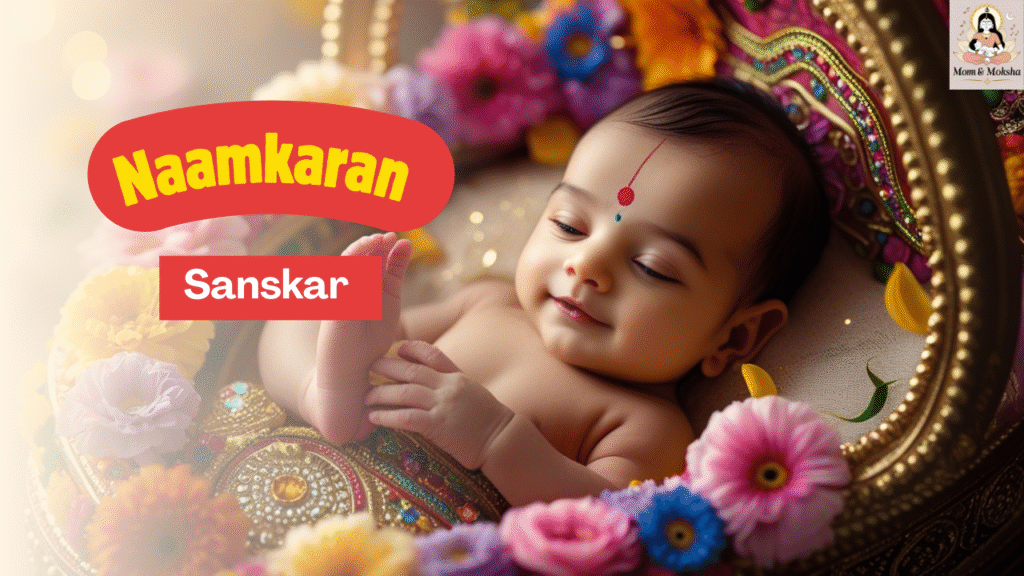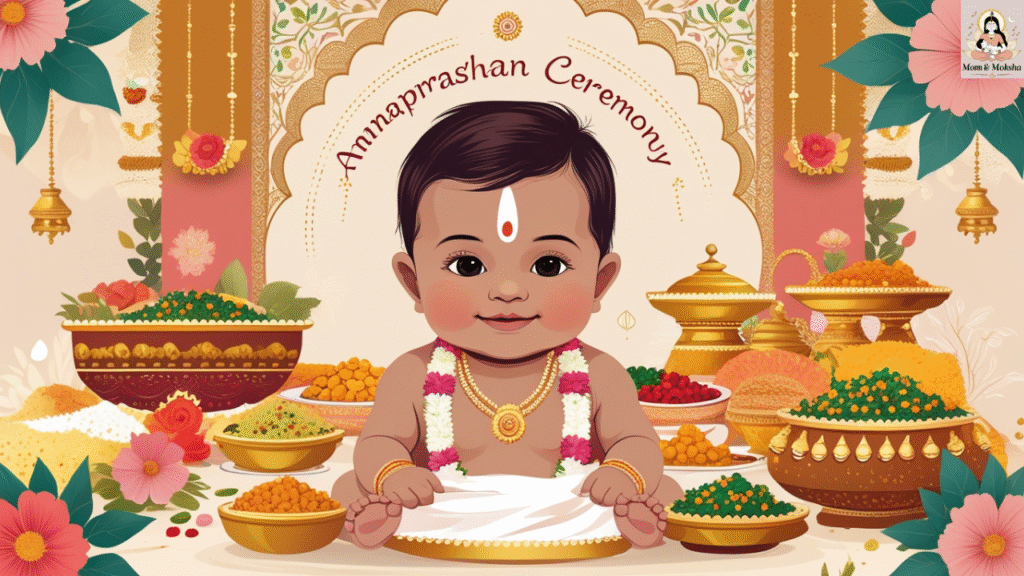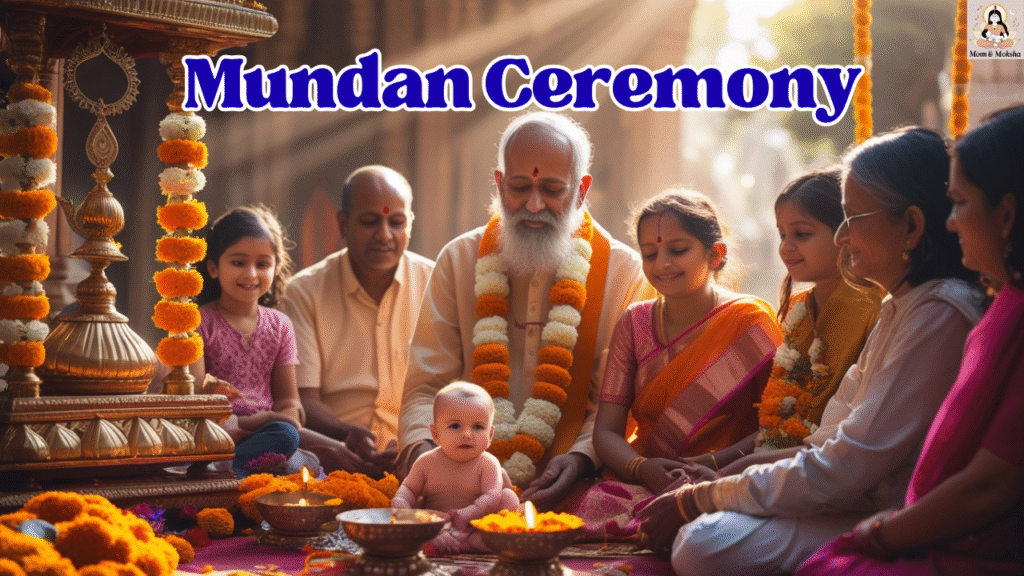✨ Introduction
In Sanatan Dharma, a baby’s name is not chosen randomly it is a sacred vibration that shapes destiny. Unlike modern trends of scrolling through “unique baby names” online, our ancestors followed a time-tested ritual called Naamkaran Sanskar, one of the 16 Shodasha Samskaras, where the child’s name was aligned with cosmic energy, birth stars, deities, and blessings of elders. – Even while choosing names, the Gita reminds us to focus on qualities and virtues over material appeal.”
The belief is beautifully expressed in the Chhandogya Upanishad (VII.2.1):
“In the beginning was only Name. By Name is all known. By Name is all made firm.”
This shows how deeply Sanatan Dharma valued names—not as a label, but as a mantra carrying sound energy (Shabda Brahman). Let’s explore this profound ritual in depth.
🌿 What is Naamkaran Sanskar?
- Definition: Naamkaran (नामकरण) = “giving a name.”
- Position among Sanskaras: It is the 5th Sanskar after Garbhadhan, Pumsavana, Simantonayan, and Jatakarma.
- Timing: Traditionally performed on the 11th, 12th, or 13th day after birth, though in some traditions it may be done up to the 100th day or even in the first year.
- Purpose: To formally welcome the child into the community, invoke divine blessings, and assign a sound vibration aligned with the cosmos.
📖 Vedic Reference: Manusmriti (2.32) mentions that a child should be named in a manner that reflects auspiciousness, culture, and virtue. The Grihya Sutras (domestic ritual manuals) also detail the process of performing Naamkaran with specific mantras.
🔮 How Names Are Traditionally Chosen in Sanatan Dharma
Navratri festival marks the beginning of a new spiritual cycle every year, much like the Namakaran Sanskar marks the auspicious start of a newborn’s identity. The process is not just cultural—it is astrological, spiritual, and psychological. Choosing a name is the first step in shaping a child’s identity spiritual parenting ensures that identity grows in the right direction.
1. By Nakshatra (Birth Star)
Every child is born under a specific Nakshatra (lunar constellation), divided into 4 padas (quarters). Each pada corresponds to syllables that are considered auspicious for names.
- Example:
- Ashwini Nakshatra: “Chu, Che, Cho, La”
- Rohini Nakshatra: “O, Va, Vi, Vu”
- Mrigashira Nakshatra: “Ve, Vo, Ka, Ki”
So, if a baby is born in Rohini Pada 2, names starting with “Va” (like Varun, Vanya, Vasudha) would be suggested.
📖 Reference: Brihat Samhita by Varahamihira provides details of Nakshatras and their corresponding syllables.
2. By Rashi (Moon Sign)
- Some families prefer naming based on the Moon sign (Rashi) of the baby.
- Example:
- Mesha Rashi (Aries): Names starting with “A, L”
- Vrishabha Rashi (Taurus): Names starting with “Ba, Va”
This ensures the child’s name harmonizes with planetary positions.
3. By Deity Association (Daiva Nama)
Parents often dedicate the child’s name to a deity for lifelong protection.
- Boys may be named after Vishnu, Shiva, Krishna, or Ram.
- Girls may be named after Lakshmi, Durga, Parvati, or Saraswati.
This is called Daiva Nama (Divine Name) and ensures the child grows with the vibrations of devotion.
📖 Reference: Bhagavata Purana mentions how Lord Krishna was given multiple names—Govinda, Gopala, Vasudeva—each carrying spiritual significance.
4. By Family or Gotra Tradition (Kula Nama)
Some names are carried forward in lineages.
- Example: A boy may be named after his grandfather or a revered ancestor.
- This maintains family continuity and dharmic pride.
5. By Numerology and Sound Vibration
- Names are sometimes checked for balance with the baby’s horoscope.
- Vedic thought emphasizes that sound = energy. A soft name soothes (like Anaya), while strong syllables give courage (like Arjun).
📖 Reference: The concept of Shabda Brahman (Sound as Ultimate Reality) in the Vedas reinforces why name vibrations matter.
📜 Baby Names by Nakshatra (Vedic Chart)
| Nakshatra | Syllables | Boy Names (Examples) | Girl Names (Examples) |
|---|---|---|---|
| Ashwini | Chu, Che, Cho, La | Chiranjeev, Charan, Lalit | Charvi, Chhavi, Lavanya |
| Bharani | Li, Lu, Le, Lo | Lishaan, Lokesh, Luv | Lipika, Lopa, Leela |
| Krittika | A, Ee, U, Ea | Arjun, Eeshan, Uday | Ananya, Eesha, Uma |
| Rohini | O, Va, Vi, Vu | Omkar, Varun, Vivek | Vanya, Vaidehi, Ojasvi |
| Mrigashira | Ve, Vo, Ka, Ki | Kiran, Venu, Vedant | Kirti, Komal, Kavya |
| Ardra | Ku, Gha, Ing, Jha | Kushal, Ghananand, Jhankar | Kumud, Ghanika, Jhanvi |
| Punarvasu | Ke, Ko, Ha, Hi | Keshav, Hari, Harish | Hita, Hemangi, Komalika |
| Pushya | Hu, He, Ho, Da | Hemant, Harendra, Devansh | Hemlata, Homa, Damini |
| Ashlesha | De, Du, Do, Di | Deepak, Dushyant, Dron | Devika, Doyel, Durga |
| Magha | Ma, Mi, Mu, Me | Madhav, Mihir, Mukul | Meenal, Mridula, Malvika |
| Purva Phalguni | Mo, Ta, Ti, Tu | Mohan, Tanay, Tushar | Mohini, Tanisha, Tulika |
| Uttara Phalguni | Te, To, Pa, Pe | Tejas, Parth, Pankaj | Tanvi, Pihu, Pooja |
| Hasta | Pu, Sha, Na, Tha | Pushkar, Shashank, Nayan | Purnima, Shalini, Nalini |
| Chitra | Pe, Po, Ra, Re | Prem, Rajiv, Raghav | Reva, Renu, Pooja |
| Swati | Ru, Re, Ro, Ta | Rohan, Tarun, Ruturaj | Roopa, Reetika, Tanvi |
| Vishakha | Ti, Tu, Te, To | Tejendra, Tushar, Tithesh | Tia, Tejal, Tulsi |
| Anuradha | Na, Ni, Nu, Ne | Nikhil, Neel, Niraj | Nidhi, Nupur, Neha |
| Jyeshtha | No, Ya, Yi, U | Yogesh, Yuvraj, Uday | Yashika, Yukti, Urmi |
| Mula | Ye, Yo, Ba, Bi | Yeshwant, Balram, Bipin | Yamini, Bina, Yogita |
| Purva Ashadha | Bu, Dha, Fo, Da | Dhruv, Bhushan, Buvan | Bhumi, Dhanvi, Bhumika |
| Uttara Ashadha | Be, Bo, Ja, Ji | Jayant, Jignesh, Boman | Jiya, Beena, Bhoomi |
| Shravana | Ju, Je, Jo, Khi | Jugal, Joyal, Kiran | Jyoti, Jigna, Khyati |
| Dhanishta | Ga, Gi, Gu, Ge | Gaurav, Gitesh, Gopal | Gita, Gauri, Geetika |
| Shatabhisha | Go, Sa, Si, Su | Sagar, Siddharth, Suraj | Sita, Sukanya, Sonia |
| Purva Bhadrapada | Se, So, Da, Di | Sohan, Deepak, Divyansh | Sonia, Seema, Disha |
| Uttara Bhadrapada | Du, Tha, Jha, Na | Dhruv, Jhanak, Nandan | Dhanya, Jhilmil, Naina |
| Revati | De, Do, Cha, Chi | Dev, Chaitanya, Chiman | Devika, Chhaya, Chitra |
📖 Note for parents: The names given above are just examples. You can adapt them creatively, blending Vedic syllables with modern naming trends to balance tradition and uniqueness.
🔔 Naamkaran Sanskar (Naming) | Step-by-Step Guide
1) Preparation (1–2 days before)
A. Fix the Muhūrta
- Consult the family priest/astrologer for a saumya (gentle) lunar day, suitable tithi, and the baby’s janma-nakshatra/pada to finalize the starting syllable(s).
B. Assign roles
- Priest (if available), parents, grandparents/elder (who will publicly announce the name), one family member to handle puja items & recording.
C. Space & layout (simple Vastu)
- A clean, quiet room with altar facing East if possible; seat the baby so the name can be whispered in the right ear comfortably (see regional notes below).
D. Samagrī checklist
- Altar/base: chowki or low table, clean cloth (white/yellow).
- Deity & sanctification: small Śrī Gaṇeśa murti/photo, kalasha (copper/steel pot), water, mango/betel leaves, turmeric, kumkum, raw rice (akṣata), sandal paste, flowers/garland, incense, lamp (dīya), camphor.
- Homa (optional, advanced): havan kuṇḍa, samidh, ghee, havan-sāmagri, spoon (sruva).
- Offerings/prasāda: fruits, dry fruits, sweets (avoid honey for infants; see safety).
- Ritual aids: plate/tray with raw rice to write the name, betel leaf for whispering, thread (rakṣā/mauli), bell, conch (optional).
- Documents: baby’s nakshatra note, chosen starting syllable(s), short name announcement card for photos/social.
- Hygiene: hand sanitizer, soft cotton, wipes; ensure good ventilation (especially if using incense or homa).
Newborn safety notes
- Do not put honey on the baby’s tongue (a custom from older Jātakarma variants). Infants <12 months must not be given honey due to infant botulism risk (WHO). (World Health Organization, PMC)
- Keep smoke minimal; seat baby away from incense/homa. (Pediatric guidance favors smoke-free indoor air for infants.)
2) Simple Home Puja Flow (no homa; ~25–35 minutes)

- Ācamana & Śuddhi
Everyone washes hands; brief mental purification. - Dīpa-prajjvālana (light the lamp)
One parent lights the lamp and incense. - Gaṇeśa Pūjā (Opening)
Short invocation (e.g., “Om Gaṁ Gaṇapataye Namaḥ”) and a flower offering to remove obstacles. - Kalaśa-sthāpana & Puṇyāhavācana (Sanctifying water)
- Fill kalasha with clean water; place 5 mango/betel leaves; a coconut on top (optional).
- Chant brief puṇyāhavācana (sanctifying) verses or a simple prayer; lightly sprinkle sanctified water around the altar and room.
- Sankalpa (Intention statement)
One parent (or the priest) states:
“In [city], on [tithi/date], during [nakshatra], we, of [gotra], perform Nāmakaraṇa Saṁskāra for our child, seeking long life (āyus), wisdom (medhā), and dharmic conduct.”
(Include baby’s birth details silently or aloud as per family custom.) - Name selection statement
- Briefly mention the basis (nakshatra syllable, deity, family tradition).
- Optionally show a small syllable chart to guests (great photo moment).
- The Naming Act (Karna-mantra / Whispering)
- Hold a betel leaf near the baby’s right ear and whisper the chosen name 3 times (common practice) — some traditions whisper a set of four names (formal/ceremonial, deity, family, and the public name). Both forms exist in textual and regional practice. (Easy Ayurveda, hinduvedictemple.org)
- Immediately write the name with a finger in a tray of raw rice (or on a silver/clean plate).
- Public announcement
- The father or an elder announces the name to everyone present (you can do a reveal card, flower petal shower, or ring the bell/conch).
- Āśīrvāda (Blessings)
- Elders touch the baby’s head/feet lightly, place a pinch of akṣata (blessed rice) near the baby, and offer short blessings (āyur-ārōgya-saubhāgya).
- A brief ārati to the baby and deities.
- Naivedya & Prasāda
- Offer fruits/sweets to the deity; then distribute prasāda to all. (Again, no feeding honey to the baby.)
Why this works: This simple flow retains the scriptural core (Gaṇeśa invocation, sanctification, sankalpa, name-giving, public declaration, blessings) while staying newborn-friendly and apartment-friendly.
3) Expanded Vedic Flow (with brief homa; ~55–75 minutes)
Use this when a priest is available and the family prefers a śāstra-guided ceremony.
- Praveśa & Śānti — short Gṛha-śuddhi & Puṇyāhavācana.
- Gaṇapati Pūjā & Pañcāyatana (optional quick offerings to Śiva, Viṣṇu, Devī, Sūrya, Gaṇeśa).
- Navagraha/Nakshatra Śānti (optional): brief mantra-nyāsa for the baby’s janma-nakshatra to invoke auspiciousness.
- Homa Setup: light Agni; offer ghee with short repeated mantras (the priest selects; many use Āyur-mantras and Medhā-sūktas).
- Sankalpa (formal, with gotra, lineage, birth data).
- Kara-sparśa & Rakṣā: tie a mauli (protection thread) to baby/parents; invoke Ayur-devatās.
- Nāmakaraṇa Kriyā:
- Whisper the name near the right ear (3x), or pronounce a sequence of names as per regional sūtra tradition; some lineages specify phonetic qualities/length for boys’ names (e.g., Aśvalāyana mentions sonant start, semivowel, visarga ending; 2 or 4 syllables). (Australian Council Of Hindu Clergy Inc.)
- Write the name in a rice tray and show it to Agni/deity.
- Āśīrvāda, Ārati & Puṣpavṛṣṭi (flower shower).
- Pūrṇāhuti & Nivedana — final oblation; distribute prasāda.
Classical anchors:
• Aśvalāyana Gṛhya Sūtra: naming procedure & phonetic rules for boys’ names.
• Manusmṛti 2.32–2.33: naming principles (euphony/meaning; historical social markers—many modern families naturally ignore caste-markers). (Internet Archive)
• Chāndogya Upaniṣad 7: primacy of Name (nāma) in knowledge hierarchy. (Wisdom Library)
4) Script-safe “Sankalpa” template (fill-in)
Use this verbatim-safe, short form (priest can expand):
“Śubha tithau, śubha nakṣatre, śubha muhūrte, asmin gṛhe vayaṁ Nāmakaraṇa Saṁskāraṁ kurmaḥ. Bālasya āyur-ārogya-medhā-saubhāgyasiddhyarthaṁ. [Baby’s chosen name] iti nāma karomi/kurmaḥ.”
Translation: “On this auspicious date, star and moment, in this home we perform the Name-giving rite for our child, seeking long life, health, intelligence and good fortune, and we give the name [Name].”
🌸 Modern-Day Tips for Parents
- ✅ Blend Tradition & Creativity: Use Nakshatra syllables but modernize the name.
- Example: Nakshatra suggests “La” → instead of “Lalit,” choose “Lavanya” or “Lael.”
- ✅ Keep it Global-Friendly: Pick names easy to pronounce across cultures (important for kids studying/working abroad).
- ✅ Spiritual + Practical: Pair a traditional name with a short nickname (e.g., Saanvi → Sia).
- ✅ Check Meaning: Ensure the Sanskrit meaning is positive (some popular names actually mean sorrow or destruction).
- ✅ Eco-Friendly Celebrations: Skip heavy rituals if not possible—light a diya, chant a small mantra, and announce the name in a sacred way.
🌼 Conclusion
Naamkaran Sanskar is more than naming a child—it is gifting them their first mantra, their lifelong vibration, their soul’s identity. In Sanatan Dharma, names carry blessings of planets, ancestors, and divine energies.
Whether you follow every Vedic step or adapt it to modern life, remember:
👉 Your child’s name is not just a word—it’s the sound of their destiny.
🙋♀️ FAQs on Naamkaran Sanskar
Q1. When should Naamkaran be done?
Traditionally on the 11th–13th day, but it can be performed anytime within the first year, depending on health and astrology.
Q2. Can non-religious parents do Naamkaran?
Yes—light a diya, offer prayers in your own way, and announce the name before family and friends.
Q3. Do all Hindu families follow Nakshatra syllables?
Not strictly. Some prefer deity names, numerology, or simply ancestral names.
Q4. Can a child have two names?
Yes. Traditionally, children had: Daiva Nama (sacred name, used in rituals) Vyavaharika Nama (social name, used in daily life)
Q5. What if we want a modern/Western name?
You can still align it with Nakshatra syllables. For example, Nakshatra suggests “A” → you may choose Ariana instead of Ananya.



